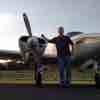16 Apr 2024, 19:58 [ UTC - 5; DST ]
|

|
Username Protected
|
Post subject: Re: Boeing 777-9 Test Flight!  Posted: Posted: 16 May 2020, 08:51 |
|
 |

|
|
 |

Joined: 08/26/15
Posts: 9542
Post Likes: +8779
Company: airlines (*CRJ,A320)
Location: Florida panhandle
Aircraft: Travel Air,T-6B,etc*
|
|
Username Protected wrote: What is the triangle on a wire behind the rudder? It looks like the test instrumentation that normally dangles far behind the airplane (aerodynamically far enough away that it's outside the strongest part of the wake and getting "clean," free stream air data), except it's reeled in for takeoff and landing. It's the same idea as those giant pitot-static-vane probes sticking way out in front on some test airplanes. Here's a picture that makes a good illustration (took me some searching).  Think of the indicated airspeed vs calibrated airspeed correction chart in your airplane's manual. How did they figure out that the airspeed indicator reads 1 knot fast at this part of the chart, it's dead on at such-and-such airspeed, but over here 1½ knots slow? That's one of the things that comes from this kind of test instrumentation. In one of the 737 MAX threads we talked about the air data computers having airspeed correction tables for high angle of attack. That would be a good example of another thing to map during test.
|
|
| Top |
|
|
Username Protected
|
Post subject: Re: Boeing 777-9 Test Flight!  Posted: Posted: 16 May 2020, 08:56 |
|
 |

|
|


Joined: 08/24/13
Posts: 8444
Post Likes: +3684
Company: Aviation Tools / CCX
Location: KSMQ New Jersey
Aircraft: TBM700C2
|
|
Username Protected wrote: What is the triangle on a wire behind the rudder? It looks like the test instrumentation that normally dangles far behind the airplane (aerodynamically far enough away that it's outside the strongest part of the wake and getting "clean," free stream air data), except it's reeled in for takeoff and landing. It's the same idea as those giant pitot-static-vane probes sticking way out in front on some test airplanes. Here's a picture that makes a good illustration (took me some searching).  Think of the indicated airspeed vs calibrated airspeed correction chart in your airplane's manual. How did they figure out that the airspeed indicator reads 1 knot fast at this part of the chart, it's dead on at such-and-such airspeed, but over here 1½ knots slow? That's one of the things that comes from this kind of test instrumentation.
Trailing cone static port, its what we use for RVSM cert.
|
|
| Top |
|
|
Username Protected
|
Post subject: Re: Boeing 777-9 Test Flight!  Posted: Posted: 16 May 2020, 09:33 |
|
 |

|
|
 |

Joined: 08/26/15
Posts: 9542
Post Likes: +8779
Company: airlines (*CRJ,A320)
Location: Florida panhandle
Aircraft: Travel Air,T-6B,etc*
|
|
Username Protected wrote: Trailing cone static port, its what we use for RVSM cert. Ah- thanks! 
|
|
| Top |
|
|
Username Protected
|
Post subject: Re: Boeing 777-9 Test Flight!  Posted: Posted: 16 May 2020, 09:51 |
|
 |

|
|
 |


Joined: 02/08/08
Posts: 5530
Post Likes: +3548
Location: Seattle
Aircraft: A36
|
|
NASA paper on the topic here.
Please login or Register for a free account via the link in the red bar above to download files.
_________________
-Bruce
bruceair.wordpress.com
youtube.com/@BruceAirFlying
|
|
| Top |
|
|
Username Protected
|
Post subject: Re: Boeing 777-9 Test Flight!  Posted: Posted: 20 May 2020, 03:16 |
|
 |

|
|


Joined: 06/16/10
Posts: 130
Post Likes: +52
Location: Toronto, Canada
Aircraft: 601P
|
|
Username Protected wrote: There's an unfortunate moment (about 0:55) in that video where he describes that they approached the folding wingtip like they do the rest of their flight control systems 
|
|
| Top |
|
|
Username Protected
|
Post subject: Re: Boeing 777-9 Test Flight!  Posted: Posted: 21 May 2020, 20:13 |
|
 |

|
|

Joined: 11/11/17
Posts: 1184
Post Likes: +1852
Location: KOLV
Aircraft: A36, 767
|
|
Username Protected wrote: Anyone know what the control surface behind the engine is? Almost looks like some kind of thrust vectoring It's an inboard aileron. They droop when Flaps 5 or more, so at rest they match the flaps profile since that's their new neutral.
|
|
| Top |
|
|
You cannot post new topics in this forum
You cannot reply to topics in this forum
You cannot edit your posts in this forum
You cannot delete your posts in this forum
You cannot post attachments in this forum
|

Terms of Service | Forum FAQ | Contact Us
BeechTalk, LLC is the quintessential Beechcraft Owners & Pilots Group providing a
forum for the discussion of technical, practical, and entertaining issues relating to all Beech aircraft. These include
the Bonanza (both V-tail and straight-tail models), Baron, Debonair, Duke, Twin Bonanza, King Air, Sierra, Skipper, Sport, Sundowner,
Musketeer, Travel Air, Starship, Queen Air, BeechJet, and Premier lines of airplanes, turboprops, and turbojets.
BeechTalk, LLC is not affiliated or endorsed by the Beechcraft Corporation, its subsidiaries, or affiliates.
Beechcraft™, King Air™, and Travel Air™ are the registered trademarks of the Beechcraft Corporation.
Copyright© BeechTalk, LLC 2007-2024
|
|
|
|



